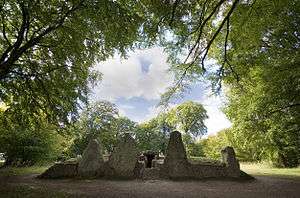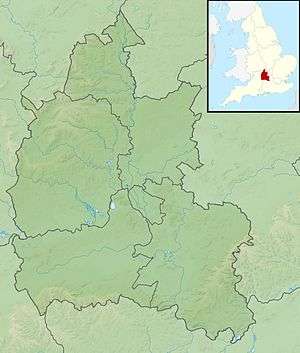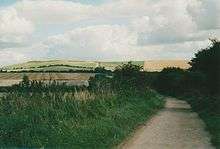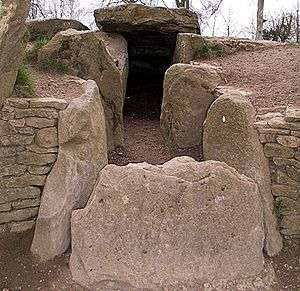Wayland's Smithy
 The long barrow entrance | |
 Map showing location in Oxfordshire | |
| Location | near Ashbury |
|---|---|
| Region | Oxfordshire England |
| Coordinates | 51°34′2.02″N 1°35′42.95″W / 51.5672278°N 1.5952639°WCoordinates: 51°34′2.02″N 1°35′42.95″W / 51.5672278°N 1.5952639°W |
| Type | long barrow and chamber tomb |
| History | |
| Periods | Neolithic |
| Site notes | |
| Excavation dates | 1962-63 |
| Archaeologists | Stuart Piggott |
| Condition | Restored |
| Public access | Yes |
| Website | English Heritage |
| Designated | 1882 [1] |
| Reference no. | PRN7306[2] |
Wayland's Smithy is a Neolithic long barrow and chamber tomb site located near the Uffington White Horse and Uffington Castle, at Ashbury in the English county of Oxfordshire. It is very near to The Ridgeway, an ancient road running along the Berkshire Downs.
Archaeologists have established that the monument was built by pastoralist communities shortly after the introduction of agriculture to Britain from continental Europe. Although representing part of an architectural tradition of long barrow building that was widespread across Neolithic Europe, Wayland's Smithy belongs to a localised regional variant of barrows produced in the south-west of Britain, now known as the Severn-Cotswold group. Of these, it is in one of the best surviving conditions.
The later mound was 185 feet (56 m) long and 43 feet (13 m) wide at the south end. Its present appearance is the result of restoration following excavations undertaken by Stuart Piggott and Richard Atkinson in 1962–63. They demonstrated that the site had been built in two different phases, a timber-chambered oval barrow built around 3590 and 3550 BC and a later stone-chambered long barrow in around 3460 to 3400 BC.[3]
Context

The Early Neolithic was a revolutionary period of British history. Between 4500 and 3800 BCE, it saw a widespread change in lifestyle as the communities living in the British Isles adopted agriculture as their primary form of subsistence, abandoning the hunter-gatherer lifestyle that had characterised the preceding Mesolithic period.[4] This came about through contact with continental societies, although it is unclear to what extent this can be attributed to an influx of migrants or to indigenous Mesolithic Britons adopting agricultural technologies from the continent.[5]
Site description
The wooden mortuary house mainly consisted of a paved stone floor with two large posts at either end. A single crouched burial had been placed at one end and the mostly disarticulated remains of a further 14 individuals were scattered in front of it. Analysis of these remains indicated that they had been subjected to excarnation before burial and deposited in possibly four different phases. Postholes at one end have been interpreted as supporting a timber facade. The whole monument was covered by an earth barrow with material excavated from two flanking ditches and measured around 20m in length.[3]
The later stone tomb consists of two opposing transept chambers and terminal chamber; along with the longer entrance chamber, this gives the burial area a cruciform appearance in plan. At the entrance four large sarsen stones stand (originally six, but two are lost), having been returned to their upright locations following the 1962 excavations.[6] It is classified by archaeologists as one of the Severn-Cotswold tombs. The large trapezoidal earth barrow erected over it was revetted with a stone kerb and its material was again excavated from two large flanking ditches. Excavation in 1919 revealed the jumbled remains of seven adults and one child.[7]
The site is important as it illustrates a transition from a timber-chambered barrow to stone-chamber tomb over a period that may have been as short as 50 years. Carbon dating of the burials in the second tomb suggest it was a late use of this style of burial, being similar to West Kennet Long Barrow, which had been in use 200 years before.[7]
Wayland's Smithy is one of many prehistoric sites associated with Wayland or Wolund, a Germanic smith-god. The name was seemingly applied to the site by the Saxons who settled in the area some four thousand years after Wayland's Smithy was built. The first documented use of the name was in 955 AD, in a Saxon charter of King Eadred.[8]
Folklore
In 1738, Francis Wise recorded a belief held about the site in local folklore.[9] Like several other early commentators, Wise referred to the site not as "Wayland's Smithy", but only as "Wayland Smith".[10] Wise related that:
- All the account which the country people are able to give of it is 'At this place lived formerly an invisible Smith, and if a traveller's Horse had lost a Shoe upon the road, he had no more to do than to bring the Horse to this place with a piece of money, and leaving both there for some little time, he might come again and find the money gone, but the Horse new shod.[11]
The deposition of coins at the site has taken place since at least the 1960s, with visitors lodging the coins into cracks in the site's stones.[12] As of 2015, the local wardens from The National Trust are tasked with removing said deposits, and circa 2010 English Heritage removed information about the coin deposition custom from the site's information panel.[12] The coins removed by the wardens are then donated to local charities.[13] As the folklorist Ceri Houlbrook noted, all of this deposited material "contributes to the ritual narrative of a site", being "integral to the contextualisation of a site".[14]
Cultural references
Walter Scott's Elizabethan novel Kenilworth (published 1821) features both the stone chambered tomb and a character named 'Wayland Smith'.[8]
Julian Cope included a song called "Wayland's Smithy Has Wings" on his 1992 album The Skellington Chronicles.
Author Patricia Kennealy-Morrison has a protagonist named Turk Wayland in her Rennie Stride mystery series, and sets a scene at the end of the fourth book, A Hard Slay's Night: Murder at the Royal Albert Hall, at Wayland's Smithy.
Rudyard Kipling, in his interlinked collection of stories Puck of Pook's Hill, set many of the stories near the Smithy, and told of the arrival of the smith god in the first.
Both the Uffington White Horse and Wayland's Smithy were incorporated into the BBC miniseries The Moon Stallion, produced in 1978. In the serial, set in 1906, the stones are associated with witchcraft.[15]
The British music group Radiohead recorded a music video here for their non-album single "Pop Is Dead".
 Wayland's Smithy, tomb (detail)
Wayland's Smithy, tomb (detail)- The entrance
 Side view
Side view Side view at dusk
Side view at dusk- The top of the tomb
See also
References
Footnotes
- ↑ Hunter, Robert (1907). "
 Appendix A". The Preservation of Places of Interest or Beauty. Manchester University Press. Wikisource.
Appendix A". The Preservation of Places of Interest or Beauty. Manchester University Press. Wikisource. - ↑ Museums and Archaeology - Oxfordshire Historic Environment Record
- 1 2 Archaeological history and research: English Heritage, accessed 27 June 2014
- ↑ Hutton 1991, pp. 16–17.
- ↑ Hutton 1991, p. 16; Ashbee 1999, p. 272; Hutton 2013, pp. 34–35.
- ↑ Ancient Britain - Wayland's Smithy
- 1 2 history and research: Waylands Smithy II. English Heritage, accessed 27 June 2014
- 1 2 berkshirehistory.com/waylands_smithy, David Nash Ford, 2003. Accessed 27 June 2014
- ↑ Ellis Davidson 1958, p. 146.
- ↑ Ellis Davidson 1958, p. 147.
- ↑ Ellis Davidson 1958, pp. 146–147.
- 1 2 Houlbrook 2015, p. 178.
- ↑ Houlbrook 2015, p. 182.
- ↑ Houlbrook 2015, p. 184.
- ↑ Bramwell 2009, pp. 167, 173–174.
Bibliography
- Ashbee, Paul (1999). "The Medway Megaliths in a European Context" (PDF). Archaeologia Cantiana. Kent Archaeological Society. 119: 269–284.
- Bramwell, Peter (2009). Pagan Themes in Modern Children's Fiction: Green Man, Shamanism, Earth Mysteries. New York: Palgrave Macmillan. ISBN 978-0-230-21839-0.
- Grinsell, Leslie V. (1976). Folklore of Prehistoric Sites in Britain. London: David & Charles. ISBN 0-7153-7241-6.
- ——— (1979). "Notes on the Folklore of Prehistoric Sites in Britain". Folklore. 90 (1): 66–70.
- Houlbrook, Ceri (2015). "The Penny's Dropped: Renegotiating the Contemporary Coin Deposit". Journal of Material Culture. 20 (2): 173–189. doi:10.1177/1359183515577120.
- Hutton, Ronald (1991). The Pagan Religions of the Ancient British Isles: Their Nature and Legacy. Oxford and Cambridge: Blackwell. ISBN 978-0-631-17288-8.
- ——— (2013). Pagan Britain. New Haven and London: Yale University Press. ISBN 978-0-300-197716.
External links
| Wikimedia Commons has media related to Wayland's Smithy. |